#puddlers
Text












🪨 Mineral gathering dragon 🪨
(M) Dragon swallowtail (Sericinus montela)
#photographers on tumblr#my photography#original photographers#art#lensblr#photography#insect photography#wildlife photography#macro photography#nature photography#nature#naturecore#insect#dragon#butterfly#parnassiinae#swallowtail butterfly#bugblr#entomology#🪨?? jesus they're minerals!!!#mineral#minerals#nutrients#puddlers#pudding#moodboard#fairycore#so precious#june 12 2024#no to generative ai
75 notes
·
View notes
Text
i realized just never posted my garden oops

please observe it in its half full glory!
don’t ask me why i planted alumroot that prefers partial shade in my afternoon sun receiving back garden ㅠ.ㅠ i wasn’t thinking practically i was just like WOW THEY HAVE SO MUCH ALUMROOT HERE and loved how curly and light these are. they’re called Dolce “Apple Twist” and the picture on the label shows they might get a little red in the centers :0 ALSO when i got these at lowes they let me pick out a free mum at checkout so now i have orange mums and no pot for them…. :D

here’s a closer image of my crazy flower corner. sorry for the patio umbrella shadow, the sun was sunning. also, don’t ask about the placement of these guys. idk what i was going for and why everything is so close, but i don’t really care i just want it fluffy and bug friendly >:3
we’ve got some multicolored asters in a row towards the front. there are little clumps of mixed wildflower seedlings trying their best but not getting very big. one bachelors button has shot up right next to the bush of catnip, u can see its tiny bud amongst the catnip if u zoom :P there’s a random baby catnip next to the bush. then, we’ve got some butterfly weed, and even more random wildflower mix babies.
in the empty space in front of the crazy flowers i have planted some SPINCH seeds!!! bloomsdale long standing spinchers to be exact.

lastly, THE HERB SPIRALLLlllwjwja!!!!!!!!!! i’ve been wanting to build one for soooooyyyyy long and i finally did it!!!!! there are dill and cilantro seeds on the lower side of the spiral. i’ve got oregano, chives, rosemary, and thyme seeds in my 4x4 seed tray. those are gonna go in the spiral obvs. i’ve also got some genovese basil in a planter i’m considering plopping into the spiral but am not sure yet…
BRO I ALMOST FORGOT. i put some peppermint seeds in a pot and two types of lavender seeds (munstead & something?...) in little nursery pots since my previous lavender seedling attempts mmmDIED </3.
also the saucer/dish with rocks is supposed to be a butterfly puddler but i’m not satisfied with it yet…suggestions welcome if you made it this far, also thank youuu byeeeee :3
not proofreading sorry i type kinda sporadically
#gardening#gardenblr#plantblr#catnip#aster#butterfly weed#herb garden#herb spiral#my garden#wildflowers
17 notes
·
View notes
Text
Are you a puddler ? Introverted puddler or extroverted puddler ? 🤣🥰 expand to read text.





13 notes
·
View notes
Text

I finished planting up the plants for my butterfly garden. I am mostly trying to attract Painted Ladies by bringing in their host plants. With zebrina mallow, wormwood, and globe thistle. For the Swallowtail butterflies I have some victoria blue salvia, pineapple sage, floristan violet liatris, lilac, and marigolds. The sheep fescue if I am lucky might attract some Western Branded Skippers. I also have a milkweed tucked into the back in case I get a rare Monarch. As I do live in the northern most edge of their range. Which I don't really expect to happen, but other butterflies love them also so no big deal.
I still need to get my hands on a rue plant to attract Anise Swallowtail and Indra Swallowtail. The ones I had seen were not looking that great so I am holding out to find healthier ones. My zinnias have just started to sprout so once the weather gets better they will get to be added.
This has been a fun project to get working on. I have wanted to make one but never really had time to plan one out. Next after this in its construction will be getting together all the stuff to make a puddler station.
Which reminds me to check if I have gotten everything needed to get it certified. It meets the requirements for North American Butterfly Association certification for a butterfly gardens. Plus with a few more additions it will meet the requirements to be a Monarch Waystation. I think I will hold off on submitting stuff until things get a little further along and can meet both.
8 notes
·
View notes
Text
Halfling Name of the Day:
Hilby Puddler
3 notes
·
View notes
Note
Are you still on a lew archer kick? ive been binging the books and something i love about them is how lew evolved as a character from a phil marlowe clone to this very empathetic and non-violent guy as the series progressed. like in the first book it feels like his blasting his automatic all whichaway but in later novels he doesnt even carry a gun.
you know, this is such a coincidence, but i picked one up last night after a little break (wycherly woman). archer really was a marlowe clone for a while. not in a bad way, if you're going to copy anybody you can pick a lot worse than raymond chandler, but it's interesting to see who lew becomes when the supports are taken off. those books are brimming with empathy. it's hard not to link that with macdonald's (his real name was kenneth millar, fun fact) life in some way. there's such care and attention put into how these people suffer because i think he understood it. i read this part last night. i don't have anything to add, i just can't stop thinking about it
She nodded solemnly, as if we were coming to an understanding. A cold quick frisson went up my back.
“Have you ever really killed anybody, Lew?”
“Yes,” I said, in the hope of unsticking the stuck record. “Eleven or twelve years ago, I killed a man named Puddler who tried to kill me.”
She leaned towards me confidentially. Her head gravitated towards my shoulder. She raised it, grasping the bottle as if it presented her only handhold in space:
“I’m being killed, too.”
“How?”
“Little by little, a piece at a time."
17 notes
·
View notes
Text
long-forgotten, lonely cairn of stones | The Terror x Stan Rogers - my playlist for @terrortracks Day 2: single artist or band
Some songs by Stan Rogers that remind me of the Terror, track list/key lyrics + honorable mentions below the cut :-)
1. Northwest Passage
“seeking gold and glory,
leaving weathered, broken bones
and a long-forgotten, lonely cairn of stones”
2. Take it From Day to Day
“no stranger, I, to the touch of steel
or the honest fear any man can feel
but I long for dust under my heels
and a pocket full of pay”
3. Make and Break Harbour
“in make and break harbour
the boats are so few
too many are pulled up and rotten
most houses stand empty
old nets hung to dry,
are blown away, lost, and forgotten”
4. Giant
“the wind’s in the north,
there be new moon tonight
but we have no circle to dance in it’s sight
so light a torch, bring the bottle,
and build the fire bright
the giant will rise with the moon”
5. The Puddler’s Tale
“there is a sign beside the gate
‘eleven days since a man lay dying’
now every shift brings fear and hate
and shaken men in terror crying”
6. Maid on the Shore
“there is a young maiden, she lives all alone
she lives all alone on the shore-o
there’s nothing she can find
to comfort her mind
but to roam all alone on the shore shore shore
but to roam all alone on the shore”
7. Half of a Heart
“that one behind you, on the padded velvet throne
don’t turn around! you’ve seen that kind before
wolves hang around here
and they hunt the woods alone
waiting for hearts
to wander through the door”
8. The Last Watch
“they brought me here to watch her in the boneyard
just two old wrecks to spend the night alone
it’s dark inside this evil place
clouds on the moon hide her disgrace
this whiskey hides my own”
Honorable Mentions
Canol Road - This song gives me such Hickey vibes (probably becuase it’s about a guy running away after murdering someone lol) but it ultimately didn’t fit The Vibes so! Snip snip!
The Jeannie C. - I like the refrain of “I will go to sea no more” because it fits Crozier but I think The Last Watch fits him better + it calls back to his “this ship knows everything about me” line so that won out (also just to clarify, the “her” mentioned in The Last Watch’s lyrics is a ship, not an actual woman lol)
White Squall - I love this song and some of the lyrics fit but sadly it just wasn’t Terror-y enough to get a spot, what can you do ¯\_(ツ)_/¯
*(Also if anyone reading this wants to check out Stan Rogers’ stuff but isn’t a fan of slower songs/ballads (which is like. 90% of this playlist) I suggest Acadian Saturday Night or Flowers of Bermuda, they’re two of my favorites! :-) )
#GOD I love terror tracks when else can I ramble about Stan Rogers for an entire tumblr post#i mean. technically I can do that whenever but like. when else do I have a REASON to do it#(also if anyone is a fan of stan rogers PLEASE jump in my inbox and yell with me about him. many thanks)#terror tracks#terror tracks 2024#terrorposting#the terror
5 notes
·
View notes
Text
i love thinking about joseph’s time back in the states after the events of BT, because a year after he comes back, the US draft is sent out to recruit as many men as possible for ww2- but joseph was able to avoid it by claiming disability. and due to the dwindling workforce, he would end up picking up a bunch of oddball jobs that needed to be filled. such as a furnace man on trains, a stevedore, a deckhand, a motorman, a puddler, a tinsmith. he very much had a zombie resume with how quickly he would come and go with all these jobs. due in part because these jobs are trades, and he certainly is not a tradesman’s. so he’d either: get fired from his job or quit because he hated it. and truthfully speaking- i don’t think he got his job as a real estate agent by himself. nepotism played a heavy part, since erina saw him struggling to maintain a workman’s job, so, she instead reached out to a friend who would offer her grandson a job to help him out. and truthfully speaking ! i think he loves his job, because it allows him to meet new people and talk for as long as as he may like. his buyers either love him or hate him because of it. but for about a decade give or take- he’d really struggle with maintaining a real workman’s job because he’s been more or less pampered for a lot of his life.
#█ ▌ 𝙜𝙤𝙣𝙚 𝙤𝙪𝙩. / ooc.#█ ▌ 𝙛𝙤𝙧 𝙩𝙝𝙚 𝙘𝙤𝙡𝙡𝙚𝙘𝙩𝙞𝙤𝙣. / headcanons.#█ ▌ 𝙩𝙧𝙞𝙘𝙠𝙨 𝙤𝙛 𝙩𝙝𝙚 𝙩𝙧𝙖𝙙𝙚. / joseph.#( im kinda in luv w the idea of joseph trying to sell his first home ….. )#( because it’s probably shit and needs a serious flip. however joseph’s charismatic personality makes it easy to find the charm in it )#( he DEFINITELY had the gift of gab and unironically makes for an excellent realtor because of it )#( he is the type of agent you meet up with and he has all kinds of foods and drinks so he can better buy your trust )#( honestly …… he’d be *too* good ….. probably why he’s insanely rich besides the generational wealth ofc )#( convinced he could sell a shit shack that has no roof or door …. just bc he’s charismatic )
5 notes
·
View notes
Text
You know what, apropos that US Steelworks Slag Dump YouTube Comment post I have not been able to get this Stan Rogers song out of my head, so here's The Puddler's Tale:
youtube
2 notes
·
View notes
Text

Merry Christmas everyone!
@narilily, @cagenewman, @chloenwckobia, @brooksienewman, @xsylcuenco, @docolives, @darpow, @ahlandrieu @stellylee
Nari
For our resident plant mama... first some really fun wine glasses! I laughed a little too hard. And the next one is a butterfly puddler, which I felt fitting because gardens and butterflies.


Cage
A backpack for your travels. You're busy and you've got a lot to do! So this is for a future trip somewhere special. And a make-your-own-game kit, something you and Colton can do together, which is pretty cool, I think!


Chloe
Some coloring pencils since we talked a little bit about being creative! Well, you can use these for just doodling or anything you want, really! And I found this plus tamagotchi which I found to be really funny and cute.


Brooksie
I saw these cufflinks that are made of the workings of a watch. They look really snazzy to me, honestly. The bag is something I also thought was pretty cool, something to help your work at the farm and moving stuff around.


Sylvia
To one of my best friends here and anywhere, I think these earrings are really cute, and they go with almost anything, right? And the slippers made me think of you, being stylish and colorful.
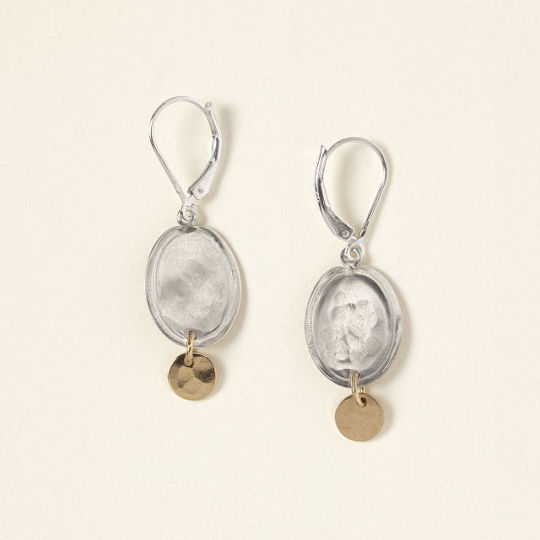

Livvy
So I hear you like squishmallows, so here is one that is a cat! Plus you have a cat named Mallow, so that's perfect, right? Next... I hear you like wine... so, a wine slushie kit to use to your heart's content!

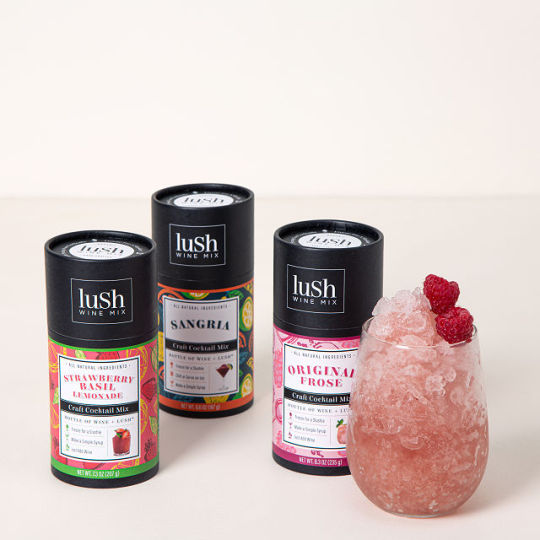
Darrius
Okay, these history quotes made me laugh. But I always love chatting with you and talking about your classes! So a cheeky mug and an even cheekier shirt.
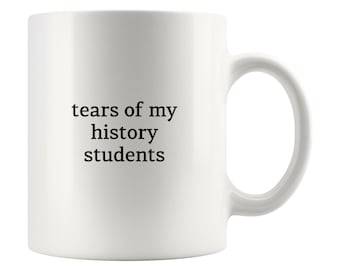
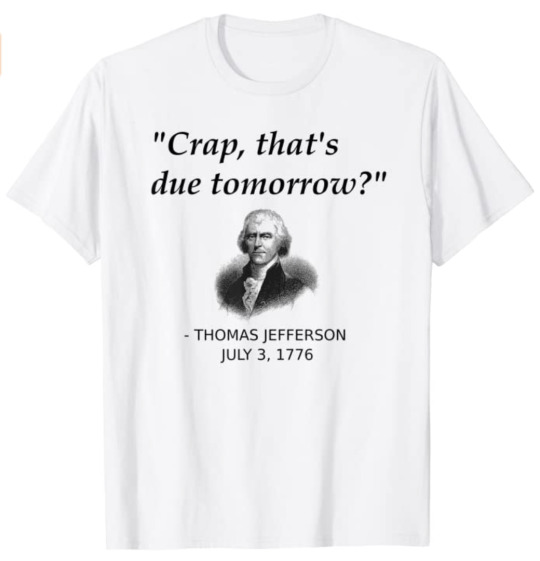
Annie
For your shopping adventures, a new tote bag! It's colorful and it's made of recycled materials, which makes it even better. And a make-your-own play dough kit for the kids!


Stelly
I hear you like music, so I found this really cool mechanical music box where you can put bumps in the sheet music to match your favorite tunes, and as you turn the crank, it plays! Next is a sunography kit! You can make pictures in the sun with this special paper.


#gifting to: nari gim#gifting to: cage newman#gifting to: chloe nwokobia#gifting to: brooksie newman#gifting to: sylvia cuenco burke#gifting to: olivia hartman#gifting to: darrius powell#gifting to: annabelle landrieu#gifting to: stelly carter#i think that's everyone#but now my head hurts so i will get to everything tomorrow#i get off work early so after i take care of stuff more replies will come
12 notes
·
View notes
Text
SLEEP: GET SOME by: a teen
I Love Sleep.
I love sleep. I don’t know why. I just love relaxing in a warm and cozy bed. I feel swaddled up and safe. Do you ever wonder about sleep? Do you question why you sleep? Or how you sleep? Or what happens when you sleep? Because I love sleep so much I had many questions about sleep so I decided to research a few of my questions to find out some answers about sleep.
Why Is Sleep Important?
There are many reasons why sleep is important. I will talk about 3 reasons.
First, sleep is “necessary for our brains to function well” (News Current).
Second, sleep “gives our body and brain a chance to rest and regenerate” (News Current). Regenerate means to regrown. When we sleep we regenerate trillions of cells that “help our body function”. “Important stuff gets saved as memories” (Puddler).
Third, sleep makes us healthier. A study done in Spain “suggests that people who sleep more are better able to avoid cancer, depressions, weight gain, and other negative health effects” (News Currents: Read to Know).
What Causes Us to Feel Sleep?
Many things can make you feel sleepy and cause you to fall asleep. For example, going to bed at the same time each night trains our brains and and makes us feel sleepy and fall asleep - usually at around the same time each night. A comfortable bed also makes some people feel sleepy. “Sometimes you sleep longer if you’ve been active” (Kent, 17). I know that if I have a long and tough day at school I come home and feel very sleepy. Staying up very late for many nights in a row can also make us feel very sleepy. This is why it is very important to go to bed on time and get the correct amount of sleep
Why Do We Have to Go to Sleep Early?
If you do not go to sleep early enough then you will not get enough sleep before it is time to wake up again the next day. If you don’t get enough sleep you will find it hard to think and concentrate. “You will feel very tired and your body will feel heavy” (Kent, 9). The worst thing that can happen when you don’t get enough sleep is that “you are irritable and cranky, even with your friends” (Kent, 9). Sometimes lacking sleep can even make you sick. This is why it is important to go to sleep on time each evening even you want stay up and watch television or play on your computer or iPad.
Why Do Some People Drool When They Sleep?
According to an article in New Moon Childrens Magazine, “when we sleep our throat muscles relax causing us to breathe through a very small opening” (36) and also causing us to open our mouths. Because everyone produces saliva in their bodies, when our mouths are open when we sleep some of the saliva (aka spit) can come out of our mouths and get on our pillows and blankets. This is called “drooling”. And this is the reason why some people drool when they are asleep. But not everyone opes their mouths when they sleep. And not everyone drools when they are asleep.
Why Do We Still Feel Tired When We Don’t Get (Enough) Sleep?
What makes us not get enough sleep? Here are some reasons :
Electricity: When we are around fake lights like computers, iPads, and televisions it resets our internal clocks. Our internal clocks tell us when to go to sleep, when to wake up, and when to eat.
Snoring: When people snore loudly it can disrupt our sleep. Even our own snoring can disrupt our sleep. If we snore it can keep us awake. It can even mean that we are “trying too hard to breathe” (New Moon: A Peep Into Sleep).
Environment: If there are loud noises, weird smells, or other things in your house or apartment that could disrupt your sleep.
Bad Habits: The biggest reason we still feel tired even when we are getting sleep is because of bad habits. This means we stay up too late, don’t eat healthy foods, don’t drink enough water (Weber, 14), are not active enough or getting enough exercise, or that we just are not sleeping for long enough hours.
“Every living animal needs to sleep”. When we get enough sleep it keeps us healthy. Sometimes we feel tired when we are not getting the proper amount of sleep. This is not good because every “body needs rest. Sleep is when a body repairs itself” (Weber, 18). Doctor’s recommend that kids gets between 8-12 hours of sleep each night. If you don’t get enough sleep you become “sleep deprived”. This means you are “denying” yourself sleep.
If you don’t get enough sleep then you will still feel tired. This is why it is important to not only get sleep but to get enough sleep. If you wake up and still feel like you need to take a nap then you are probably not getting enough sleep.
I recommend that you find "sleep" and you go get some!
0 notes
Text

To: Everlasting - @everlasting-unicorn
Three packages, wrapped in green paper and matching green ribbon. Inside: a package of bird feeders, a butterfly garden kit (wildflower seed shaker, butterfly biome, and butterfly puddler), and a picnic basket that converts into a table.
Wishing you and all your wild friends a fine meal under the sun when the snow passes.
Happy Holidays,
Secret Santa.



0 notes
Text
First Industrial Revolution
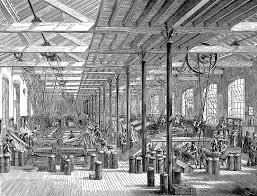
The Industrial Revolution was a significant period of economic and technological development that occurred in Europe and North America during the 18th and 19th centuries. It was a time of immense change that transformed the way goods were produced, distributed, and consumed, and it laid the groundwork for modern industrialized societies.
Factors Affected Creation
Natural resources such as coal, iron
The creation of the Industrial Revolution was a complex process that was influenced by a variety of factors. One of the most significant of these was the availability of natural resources, including coal, iron, and water. These resources were essential for powering the machinery that drove the Industrial Revolution and for providing the raw materials needed for manufacturing.
High Level of Agriculture Productivity
British Agriculture Revolution was an unprecedented increase in agricultural production in Britain arising from increases in labour and land productivity between the mid-17th and late 19th centuries. In the course of the revolution, one family began to produce enough food for five families. Much manpower was liberated from agriculture and became available for industry. Thus the Agricultural Revolution made possible the Industrial Revolution.
Financial capital available to invest
The Industrial Revolution was also driven by social and economic changes, including the growth of cities and the rise of a capitalist economy. As people moved from rural areas to cities to work in factories, a new urban working class emerged. The development of capitalist economic systems allowed for the accumulation of capital and the investment in new technologies and industries.
Political stability and a legal system that supported business
Political and legal changes, such as patent laws and the development of joint-stock companies, provided incentives for entrepreneurs and investors to develop and commercialize new technologies.
These were the main factors that affected Industrial Revolution.
Development of Industries
Iron Industry
Furnace
One of the most significant technological advances in the iron industry was the development of the blast furnace, which allowed for the production of large quantities of iron at a lower cost. The blast furnace, which was first introduced in the 18th century, used a combination of coke, iron ore, and limestone to produce pig iron, a crude form of iron that could be refined into more useful products.

The reverberatory furnace could produce cast iron using mined coal. The burning coal remained separate from the iron and so did not contaminate the iron with impurities like sulfur and silica. This opened the way to increased iron production.
Rolling and Puddling
Conversion of cast iron had long been done in a finery forge. An improved refining process known as potting and stamping was developed, but this was superseded by Henry Cort's puddling process. Cort developed two significant iron manufacturing processes: rolling in 1783 and puddling in 1784. Puddling produced a structural grade iron at a relatively low cost. Puddling was a means of decarburizing molten pig iron by slow oxidation in a reverberatory furnace by manually stirring it with a long rod. The decarburized iron, having a higher melting point than cast iron, was raked into globs by the puddler. When the glob was large enough, the puddler would remove it. Puddling was backbreaking and extremely hot work. Few puddlers lived to be 40. Because puddling was done in a reverberatory furnace, coal or coke could be used as fuel. The puddling process continued to be used until the late 19th century when iron was being displaced by steel. Because puddling required human skill in sensing the iron globs, it was never successfully mechanised. Rolling was an important part of the puddling process because the grooved rollers expelled most of the molten slag and consolidated the mass of hot wrought iron. Rolling was 15 times faster at this than a trip hammer. A different use of rolling, which was done at lower temperatures than that for expelling slag, was in the production of iron sheets, and later structural shapes such as beams, angles, and rails.

Horizontal (lower) and vertical (upper) cross-sections of a single puddling furnace. A. Fireplace grate; B. Firebricks; C. Cross binders; D. Fireplace; E. Work door; F. Hearth; G. Cast iron retaining plates; H. Bridge wall
The puddling process was improved in 1818 by Baldwyn Rogers, who replaced some of the sand lining on the reverberatory furnace bottom with iron oxide. In 1838 John Hall patented the use of roasted tap cinder (iron silicate) for the furnace bottom, greatly reducing the loss of iron through increased slag caused by a sand lined bottom. The tap cinder also tied up some phosphorus, but this was not understood at the time. Hall's process also used iron scale or rust which reacted with carbon in the molten iron. Hall's process, called wet puddling, reduced losses of iron with the slag from almost 50% to around 8%. Puddling became widely used after 1800. Up to that time, British iron manufacturers had used considerable amounts of iron imported from Sweden and Russia to supplement domestic supplies. Because of the increased British production, imports began to decline in 1785, and by the 1790s Britain eliminated imports and became a net exporter of bar iron.
Usage

The Iron Bridge, Shropshire, England, the world's first bridge constructed of iron, opened in 1781.
The growth of the iron industry was also driven by increased demand for iron products, particularly in the construction of new buildings, bridges, and railroads. Iron was used to create structural supports, reinforcing rods, and other components that were critical for the development of modern infrastructure.
Availability
The availability of natural resources was also a significant factor in the growth of the iron industry. Britain, which was the center of the Industrial Revolution, had large deposits of iron ore, coal, and limestone, which provided the raw materials necessary for iron production. The development of transportation infrastructure, such as canals and railroads, made it easier to transport these resources to the iron mills.
Growth
In the UK in 1720, there were 20,500 tons of cast iron produced with charcoal and 400 tons with coke. In 1750 charcoal iron production was 24,500 and coke iron was 2,500 tons. In 1788 the production of charcoal cast iron was 14,000 tons while coke iron production was 54,000 tons. In 1806 charcoal cast iron production was 7,800 tons and coke cast iron was 250,000 tons.
In 1750 the UK imported 31,200 tons of bar iron and either refined from cast iron or directly produced 18,800 tons of bar iron using charcoal and 100 tons using coke. In 1796 the UK was making 125,000 tons of bar iron with coke and 6,400 tons with charcoal; imports were 38,000 tons and exports were 24,600 tons. In 1806 the UK did not import bar iron but exported 31,500 tons.
The growth of the iron industry had a significant impact on the economy and society. Iron production created new jobs and industries, driving economic growth and increasing the standard of living. The availability of cheap iron products also made it easier for people to build their own homes, purchase tools, and engage in other activities that were previously prohibitively expensive.
Coal Industry
The development of the coal industry was a gradual process that began in the 16th century, when coal was first mined in Britain for use as fuel. At the time, coal was primarily used for domestic heating and cooking, but as the population grew and new industries emerged, demand for coal increased.

Steam Engine By James Watt
By the 18th century, coal was being used to power steam engines, which were being developed for a variety of purposes, including mining, transportation, and textile manufacturing. The steam engine, invented by James Watt in 1765, was a game-changing technology that allowed for the mechanization of many industries and greatly increased productivity.
The growth of the coal industry was also driven by the expansion of the transportation network, particularly the development of canals and railroads. Canals allowed coal to be transported more easily and cheaply than ever before, while railroads enabled coal to be transported faster and over longer distances. As demand for coal increased, so too did the size and scale of the industry. Large-scale coal mines were developed, often employing hundreds or thousands of workers, and new technologies were developed to extract coal more efficiently and safely.
Inventions
Coal was extracted by mining on underground. There were many hardships in this process, while water being one of the main one. Water was removed by hauling buckets of water up the shaft or to a sough (a tunnel driven into a hill to drain a mine). In either case, the water had to be discharged into a stream or ditch at a level where it could flow away by gravity. The introduction of the steam pump by Thomas Savery in 1698 and the Newcomen steam engine in 1712 greatly facilitated the removal of water and enabled shafts to be made deeper, enabling more coal to be extracted.
Coal mining was very dangerous owing to the presence of firedamp in many coal seams. Some degree of safety was provided by the safety lamp which was invented in 1816 by Sir Humphry Davy and independently by George Stephenson. However, the lamps proved a false dawn because they became unsafe very quickly and provided a weak light. Firedamp explosions continued, often setting off coal dust explosions, so casualties grew during the entire 19th century. Conditions of work were very poor, with a high casualty rate from rock falls.
Steam Power Industry
The history of steam power can be traced back to the 17th century, when inventors began experimenting with ways to use steam to power machinery. However, it was not until the late 18th century that the steam engine was developed to the point where it could be used effectively in industry. The first successful steam engine was built by James Watt in 1765, and it was used primarily for pumping water out of coal mines.
Development

Steam Engine By James Watt
The real breakthrough came in the late 1700s and early 1800s, when steam power was harnessed to power textile mills and other manufacturing processes. The steam engine was used to power spinning machines, looms, and other equipment, greatly increasing the efficiency of textile production. Steam power also allowed for the mechanization of other industries, such as iron and steel production and transportation.
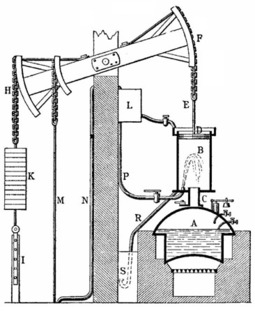
Newcomen's steam-powered atmospheric engine was the first practical piston steam engine. Subsequent steam engines were to power the Industrial Revolution.
The first successful piston steam engine was introduced by Thomas Newcomen before 1712. Newcomen engines were installed for draining hitherto unworkable deep mines, with the engine on the surface; these were large machines, requiring a significant amount of capital to build, and produced upwards of 3.5 kW (5 hp). They were also used to power municipal water supply pumps. They were extremely inefficient by modern standards, but when located where coal was cheap at pit heads, they opened up a great expansion in coal mining by allowing mines to go deeper. Despite their disadvantages, Newcomen engines were reliable and easy to maintain and continued to be used in the coalfields until the early decades of the 19th century. By 1729, when Newcomen died, his engines had spread (first) to Hungary in 1722, Germany, Austria, and Sweden. A total of 110 are known to have been built by 1733 when the joint patent expired, of which 14 were abroad.
Growth
In Britain, by 1800 an estimated 10,000 horsepower was being supplied by steam. By 1815 steam power had grown to 210,000 hp.
Advantages
One of the key advantages of steam power was that it could be used anywhere, regardless of the availability of water power. This made it possible to locate factories in urban areas, close to sources of labor and raw materials. As a result, the use of steam power helped to drive the growth of cities and the development of urban industrial centers.
Challenges
The development of steam power was not without its challenges, however. One of the biggest obstacles was the need for a reliable source of coal to power the steam engines. This led to the development of coal mines and the expansion of the coal industry, which in turn had significant environmental and social impacts. Despite these challenges, the development of steam power had a profound impact on the world economy and the course of human history. It laid the groundwork for modern industrialized societies and transformed the way goods were produced and distributed.
Glass Making Industry
The glass making industry had been around for centuries before the Industrial Revolution, but the traditional methods of producing glass were slow and inefficient. Glassmakers relied on manual labor and hand-blown glass techniques that limited the scale and speed of production. This all changed with the invention of new machines and technologies that revolutionized the glass making process.
Inventions
One of the most significant developments was the invention of the glass pressing machine in 1825 by John P. Bakewell. This machine allowed for the mass production of sheet glass, which was used for windows, mirrors, and other products. The machine worked by pressing molten glass between two rollers, which created uniform sheets of glass that could be cut to size. Another important development was the invention of the soda-lime glass making process in the 19th century. This process replaced the traditional lead glass making process, which was expensive and time-consuming. The soda-lime process used cheaper and more readily available materials, including soda ash and lime, and allowed for the mass production of glass at a lower cost.
The Industrial Revolution also saw the development of new glass making techniques, including the cylinder blown glass process and the Fourcault process. The cylinder blown glass process allowed for the production of seamless glass tubing, which was used in scientific instruments and lighting. The Fourcault process was a continuous glass making process that allowed for the mass production of flat glass sheets.
The development of new glass making techniques during the Industrial Revolution had a significant impact on the glass industry and the wider economy. The mass production of glass led to the creation of new markets and industries, including the production of bottles, mirrors, and glassware. The use of glass in construction and transportation also increased, as new techniques allowed for the production of larger and more durable glass products.
Transportation Industry
At the beginning of the Industrial Revolution, inland transport was by navigable rivers and roads, with coastal vessels employed to move heavy goods by sea. Wagonways were used for conveying coal to rivers for further shipment, but canals had not yet been widely constructed. Animals supplied all of the motive power on land, with sails providing the motive power on the sea. The first horse railways were introduced toward the end of the 18th century, with steam locomotives being introduced in the early decades of the 19th century. Improving sailing technologies boosted average sailing speed by 50% between 1750 and 1830. The Industrial Revolution improved Britain's transport infrastructure with a turnpike road network, a canal and waterway network, and a railway network. Raw materials and finished products could be moved more quickly and cheaply than before. Improved transportation also allowed new ideas to spread quickly.
Railway Industry

Painting depicting the opening of the Liverpool and Manchester Railway in 1830, the first inter-city railway in the world and which spawned Railway Mania due to its success
In the early 19th century, Britain had a transportation problem. There were no roads suitable for heavy wagons, and rivers were not efficient for long-distance transport. At the same time, the growth of industrialization was creating an ever-increasing demand for coal and other raw materials, as well as a need for faster and more efficient ways of transporting goods.
Growth
The solution was to build a network of railways that would connect the major industrial centers of the country. The first railway was built in 1804, and by 1850, there were over 6,000 miles of railway track in Britain, linking the major cities and ports.
Inventions
The development of the railway industry was made possible by several technological innovations. The steam engine, invented by James Watt in the late 18th century, provided the power needed to move heavy loads. The development of iron and steel production allowed for the construction of stronger and more durable tracks and locomotives, while new manufacturing techniques, such as mass production, made it possible to build large numbers of locomotives and carriages at a relatively low cost.
Advantages
The railways had a profound impact on the economy and society of Britain. They made it possible to transport goods and raw materials quickly and cheaply, reducing the cost of production and increasing the profitability of industry. They also made it possible for people to travel more easily and cheaply, enabling the growth of tourism and the development of new markets. The railways also helped to drive further technological innovation. The development of the railway industry led to advances in the production of steel, locomotives, and other machinery, as well as the development of new technologies, such as telegraphs and signaling systems, which made the railways safer and more efficient.
These are development of some industries in Industrial Revolution.
Social Effects
Growth of Cities
One of the most significant social effects of the Industrial Revolution was the growth of cities. As people moved from rural areas to urban centers to work in factories, cities grew rapidly, with the population of some cities increasing tenfold or more. This rapid urbanization brought about significant changes in the way people lived and interacted with each other, leading to the development of new social structures and institutions.
Family Structure
The growth of cities also brought about significant changes in the family structure. As more and more people moved to urban centers to work in factories, family structures changed, with nuclear families becoming more common. The extended family, which had been the norm in rural areas, became less prevalent as people moved away from their ancestral homes to seek work in the cities.
Women society
The Industrial Revolution also had a significant impact on the role of women in society. As factory work became more prevalent, women began to enter the workforce in larger numbers. This led to significant changes in the way women were perceived and treated, as they began to gain more independence and autonomy.
Dangerous works

A young "drawer" pulling a coal tub along a mine gallery. In Britain, laws passed in 1842 and 1844 improved mine working conditions.
However, these changes were not all positive, as the working conditions in factories were often dangerous and unhealthy, leading to widespread illness and injury. Workers, including women and children, were often forced to work long hours in hazardous conditions, with little to no access to healthcare or education.
New middle class
Another significant social effect of the Industrial Revolution was the emergence of a new middle class. As new industries and technologies emerged, new job opportunities were created, leading to the growth of a middle class. This new class of people had a significant impact on society, as they were able to afford better education, healthcare, and living conditions.
Environment
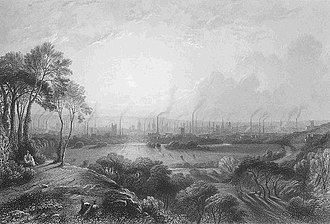
Manchester, England ("Cottonopolis"), pictured in 1840, showing the mass of factory chimneys
The Industrial Revolution had a significant impact on the environment, with the development of new technologies leading to increased pollution and deforestation. This had a significant impact on the health and wellbeing of people living in urban areas, as air and water pollution led to widespread illness and disease.
Industrialization beyond Great Britain
The Habsburg realms which became Austria-Hungary in 1867 included 23 million inhabitants in 1800, growing to 36 million by 1870. Nationally the per capita rate of industrial growth averaged about 3% between 1818 and 1870. However, there were strong regional differences. The railway system was built in the 1850–1873 period. Before they arrived transportation was very slow and expensive. In the Alpine and Bohemian (modern-day Czech Republic) regions, proto-industrialization began by 1750 and became the center of the first phases of the Industrial Revolution after 1800. The textile industry was the main factor, utilizing mechanization, steam engines, and the factory system. In the Czech lands, the "first mechanical loom followed in Varnsdorf in 1801", with the first steam engines appearing in Bohemia and Moravia just a few years later. The textile production flourished particularly in Prague and Brno (German: Brünn), which was considered the 'Moravian Manchester'. The Czech lands, especially Bohemia, became the center of industrialization due to its natural and human resources. The iron industry had developed in the Alpine regions after 1750, with smaller centers in Bohemia and Moravia. Hungary—the eastern half of the Dual Monarchy, was heavily rural with little industry before 1870.
In 1791, Prague organized the first World's Fair/List of world's fairs, Bohemia (modern-day Czech Republic). The first industrial exhibition was on the occasion of the coronation of Leopold II as a king of Bohemia, which took place in Clementinum, and therefore celebrated the considerable sophistication of manufacturing methods in the Czech lands during that time period.
Technological change accelerated industrialization and urbanization. The GNP per capita grew roughly 1.76% per year from 1870 to 1913. That level of growth compared very favorably to that of other European nations such as Britain (1%), France (1.06%), and Germany (1.51%). However, in a comparison with Germany and Britain: the Austro-Hungarian economy as a whole still lagged considerably, as sustained modernization had begun much later.
Belgium
Belgium was the second country in which the Industrial Revolution took place and the first in continental Europe: Wallonia (French-speaking southern Belgium) took the lead. Starting in the middle of the 1820s, and especially after Belgium became an independent nation in 1830, numerous works comprising coke blast furnaces as well as puddling and rolling mills were built in the coal mining areas around Liège and Charleroi. The leader was a transplanted Englishman John Cockerill. His factories at Seraing integrated all stages of production, from engineering to the supply of raw materials, as early as 1825.
Wallonia exemplified the radical evolution of industrial expansion. Thanks to coal (the French word "houille" was coined in Wallonia), the region geared up to become the 2nd industrial power in the world after Britain. But it is also pointed out by many researchers, with its Sillon industriel, 'Especially in the Haine, Sambre and Meuse valleys, between the Borinage and Liège...there was a huge industrial development based on coal-mining and iron-making...'. Philippe Raxhon wrote about the period after 1830: "It was not propaganda but a reality the Walloon regions were becoming the second industrial power all over the world after Britain." "The sole industrial centre outside the collieries and blast furnaces of Walloon was the old cloth-making town of Ghent." Professor Michel De Coster stated: "The historians and the economists say that Belgium was the second industrial power of the world, in proportion to its population and its territory [...] But this rank is the one of Wallonia where the coal-mines, the blast furnaces, the iron and zinc factories, the wool industry, the glass industry, the weapons industry... were concentrated." Many of the 19th-century coal mines in Wallonia are now protected as World Heritage sites.
Wallonia was also the birthplace of a strong socialist party and strong trade unions in a particular sociological landscape. At the left, the Sillon industriel, which runs from Mons in the west, to Verviers in the east (except part of North Flanders, in another period of the industrial revolution, after 1920). Even if Belgium is the second industrial country after Britain, the effect of the industrial revolution there was very different.
France
One of the earliest countries to experience industrialization was France. In the late 18th century, French inventors developed new technologies, such as the spinning jenny and power loom, which increased the efficiency of textile production. The French government also supported industrialization by providing incentives for entrepreneurs and investing in infrastructure projects, such as canals and railways.
Germany
Germany was another country that experienced rapid industrialization during the 19th century. The country had a large supply of coal and iron, which were essential for powering machinery and producing steel. German inventors developed new technologies, such as the steam engine and gas lighting, and the government supported industrialization by investing in infrastructure and creating a national railway system.
United States
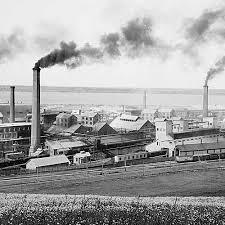
The United States also experienced significant industrialization during the 19th century. The country had a large supply of natural resources, including coal, iron, and timber, which were used to fuel the growth of manufacturing. American inventors developed new technologies, such as the telegraph, sewing machine, and typewriter, which revolutionized communication and manufacturing.
Japan
In Japan, the Meiji Restoration in 1868 marked the beginning of a period of rapid industrialization. The government recognized the importance of industrialization for economic growth and national security and invested in infrastructure, education, and technology. Japanese inventors developed new technologies, such as the steam engine and electric power, and the country rapidly modernized its manufacturing industries.
Industrial Revolution's impact was immense, transforming societies and economies around the world and laying the foundation for the modern world.
#Industrial Revolution#Industrial#Industry#Revolution#Importance#Development#Growth#Iron Industry#Coal industry#Steam Power Industry#Glass industry#Business#British#Britain
1 note
·
View note
Photo
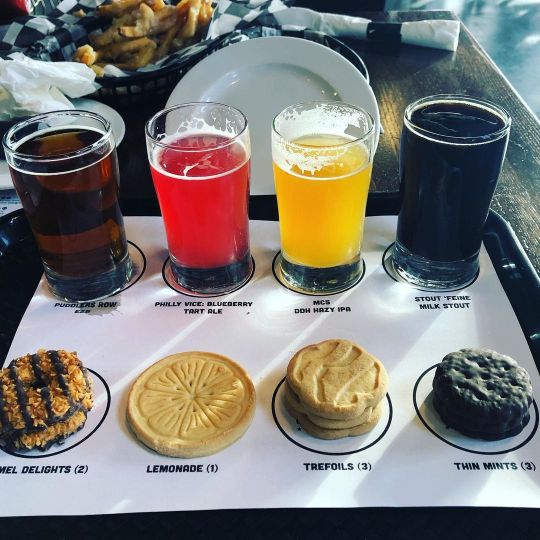
Left the house twice in one week! #WhoDis #PuddlersKitchenAndTap #GirlScoutCookie #Flight #MuyRico #SoloDates #MejorSolaQueMalAcompañada (at Puddlers Kitchen & Tap by Conshohocken Brewing Co.) https://www.instagram.com/p/CoiYDrGvT5mNPLekpxng2X61sdEfS1SSH4MpsI0/?igshid=NGJjMDIxMWI=
0 notes
Text
A post to recognize and brag about the things I've been doing well lately:
I have been brushing and flossing my teeth almost every night. I have been taking my vitamins and medications every morning.
I have been going to bed before 3 A.M. more often than not and I have been setting wake up alarms so I have the option to not oversleep even on days when I have nothing going on. I've been making a habit of using grounding techniques to soothe my brain in bed and help me get to sleep every night.
I have been consistently cleaning and refilling the puddler. This usually means I also get dressed every day instead of spending the entire day in the previous night's sleepwear.
For the most part I have been showering when I feel like I need to or when I think a refresh would be nice.
I have been staying on top of my laundry and even putting my clean clothes away somewhat regularly. I've started to put them away as a handy anxiety calming technique.
I am on track to eating breakfast, lunch, and dinner two out of the last three days. I missed only breakfast on the third day. I have managed this despite unusually aggressive IBS symptoms.
Because I have been eating more, I have been able to take painkillers for my hand and wrist pain more consistently. I've been setting alarms for doses so I don't forget and that new habit has been helping me a lot. I've also been doing stretches for my arms, hands, and wrists every day.
I have been helping a bit more around the house with loading or unloading the dishwasher and sometimes taking out trash.
I ordered a trash spear so I can now go out and clean up litter in my neighborhood as a productive and rewarding way to occupy my spare time.
I have been making phone calls and sending emails and scheduling appointments and the like more readily instead of putting them off. I've even scheduled a trip to the notary with several people for this weekend.
Earlier today I recognized when I was about to go down an Internet rabbit hole right before I needed to leave for my therapy appointment and I chose to close the app and save it for later so I would be on time for my appointment (or as close to on time as I could be with traffic).
I have done a lot of introspection over the last few days and have identified several majorly problematic habits and thought patterns that have been hurting me and the people around me. I have spoken with my therapist and my partner about them and have been making plans to change myself and my behaviors and thought patterns for the better. It's really scary, but when I think about what I and my loved ones have to gain from breaking down these old defense mechanisms – a happy life lived safely without them, and healthy long-term relationships in their place – I know that I have to do this work, as much as I can.
8 notes
·
View notes
Photo

MWW Artwork of the Day (9/6/21)
Thomas Pollock Anshutz (American, 1851–1912)
The Ironworkers' Noontime (1880)
Oil on canvas, 43.2 x 60.6 cm.
The Fine Arts Museums of San Francisco (Gift of Mr. & Mrs. John D. Rockefeller 3rd)
Thomas Pollock Anshutz spent his adolescence near the factories of Wheeling, West Virginia. During a later visit there, he sketched a group of “puddlers” —- the skilled laborers who produced sheet metal that was cut into nails —- taking a lunch break near a water pump in a factory yard. "The Ironworkers' Noontime" remains one of the most popular of Anshutz' paintings. Some of the figures are depicted in a classical pose, such as the man in the foreground rubbing his arm. This figure's pose imitates a pose from the Parthenon. Art historian Randall C. Griffin has written of it: "One of the first American paintings to depict the bleakness of factory life, 'The Ironworkers' Noontime' appears to be a clear indictment of industrialization. Its brutal candor startled critics, who saw it as unexpectedly confrontational —- a chilling industrial snapshot not the least picturesque or sublime."
18 notes
·
View notes